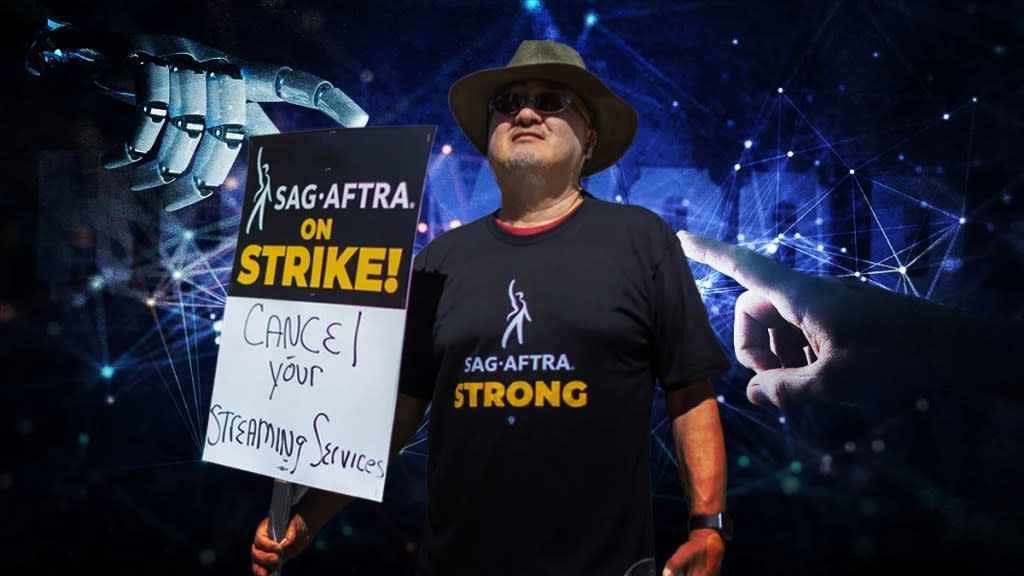‘Synthetic Performers’ Win Big in SAG-AFTRA Agreement With Studios

In the recent actors’ strike settlement, negotiators faced the unenviable task of finding ways to lock down smart answers to endless tech-transformed Hollywood questions. Nowhere was that task more difficult than to find smart and sensible solutions to very real issues and threats posed by artificial intelligence and its inevitable transformation of media and entertainment.
For the most part, the contract’s AI protections are meaningful, setting critical guardrails on issues like replicating actor images, likenesses and voices without consent before the AI genie generates itself completely out of the bottle.
But a gaping AI loophole exists in the settlement’s section about “Generative Artificial Intelligence” — a hole that is sure to be exploited by motion picture and television producers and, therefore, presents a real ongoing risk to the creative community, not to mention how we create art itself.
Specifically, there appear to be no real guardrails to prevent producers from replacing human performers with AI-generated “Synthetic Performers” — a digitally created assets that appear to be “natural performer[s]” but are “not recognizable as any identifiable natural performer.” According to SAG-AFTRA’s post-settlement “Summary of Tentative Agreement” (the full 128-page agreement has yet to be made public), the producers’ only relevant obligation is to give notice to the union “and an opportunity to bargain in good faith over appropriate consideration, if any, if a Synthetic Performer is used in place of a performer who would have been engaged under this Agreement in a human role.”
In other words, SAG-AFTRA’s membership is relying upon producers acting in good faith when considering casting us instead of synthetic humans that look and act exactly like us.
But let’s keep it real. “Synthetic” performers, unlike the real thing, require no negotiations, no contract, no fees, no perks, no care and feeding of any kind. Not even sleep! Many producers across film and television — certainly those that are budget constrained (which means essentially all of them) — will be tempted to take that AI plunge. And once they do, all bets are off.
Sure, the strike-settlement summary expressly acknowledges “the importance of human performance in motion pictures and the potential impact on employment.” But that provision has no real teeth, other than a loose agreement “to meet regularly to discuss remuneration, if any,” for use of guild member personas to train the AI that may generate their replacements (note the words “if any” in that provision). So the settlement’s feel-good “good faith” edict most certainly anticipates a new Hollywood version 2.0 in which productions can run 24/7 and AI-generated synthetic performers star in movies and series at the expense of human performers — on a meaningful scale.
Of course, we’re not quite yet in a place where the synthetic performer technology is strong and convincing enough to replace the real thing (one recent 12-minute film, “The Frost,” illustrates the current state of play for AI-generated film). But make no mistake, the time it will take to significantly narrow that gap is shorter than you think. If there is any doubt, just check out the hundreds of 100% synthetic Influencers that already boast massive numbers on social media.
Take the very human-looking synth “Miquela,” who has more than 3.5 million followers on TikTok and 2.7 million on Instagram. “She” describes herself on Instagram as being “a 19-year-old Robot living in LA.” Miquela is not just some CGI or animated character to which we have grown accustomed in Hollywood movies. “Her” (a la the movie “Her”) goal is to double as a real human influencer, and so her profile highlights very human traits. It also showcases her starring roles in high-end, real world BMW commercials and Prada ads that generate piles of very real cash for her human software coders – roles that otherwise would have gone to her humanoid friends (with whom “she snaps” pictures all the time).
Miquela is not alone of course in “her” motivations and photorealism. Check out Lu do Magalu “from Brazil” (6.6 million followers on Instagram), Imma “from Japan” (395,000 followers), and Shudu “from South Africa” who calls herself “The World’s First Digital Supermodel” (fun fact: Tyra Banks praised Shudu, thinking “she” was the real thing).
All of these “synths” work with leading luxury brands. Yes, all still carry that “uncanny” air about them (much like “The Frost” short film mentioned above). But the rapid pace of technology certainly will do its best to close that gap. So expect any one of them to star in a major film or television production near you in the not-too-distant future. Their fictional friend “Barbie” points the way.
SAG-AFTRA’s negotiators certainly did their best to draw some lines to keep humans from being overrun by the synths. But generative AI’s continuing threats to Hollywood talent are meaningful, and they are real. Ultimately, U.S. copyright law serves as Hollywood’s essential AI guardrail, since producers know that the Copyright Office gives no protection to fully AI-generated works (at least not yet).
But we humans ourselves are the most effective guardrail to not only demand our spot at the top of the creative food chain, but to cherish and nourish the notion that humanity is uniquely capable of creating an almost divine connection that can never be fully and authentically replicated.
For those of you interested in learning more, visit Peter’s firm Creative Media at creativemedia.biz and follow him on Twitter/X @pcsathy.
The post ‘Synthetic Performers’ Win Big in SAG-AFTRA Agreement With Studios appeared first on TheWrap.

